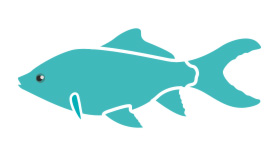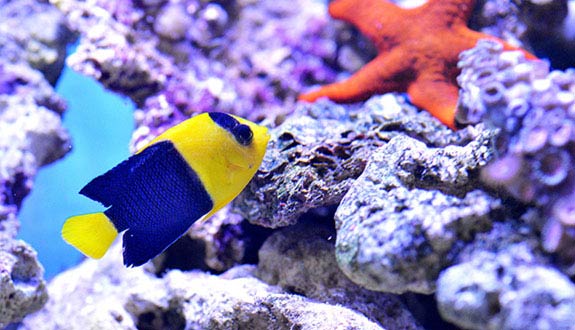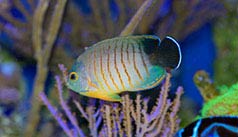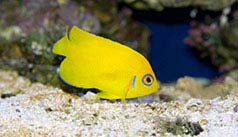

Alternative species (click on the thumbnail to see the card)
Names
Scientific name
Centropyge bicolor
Common name
Bicolor angelfish
Black and gold angelfish
Blue and gold angelfish
Two-colored angelfish
Oriole anglefish
Blaugelber Zwergkaiserfisch (D)
Origin

Origin: South Pacific Ocean and Indian Ocean
Natural habitat: it lives in the bottom of coral reefs, up to 25 m (82 feet) deep
Dimorphism

Males are larger and their anal fin ends in a point. They are often more colorful and shiny
Group

Pomacanthidae
Volume

300 L / 66 imp gal / 79 US gal
Parameters

T°: 23 à 26°C or 73 to 79°F
pH: 8 to 8.4
Density: 1021 to 1026
Difficulty

Easy
Size

up to 12cm (4.7")
Longevity

10 years
Living zone

Middle and depth
Individuals

1 or harem
Food
How to feed the Bicolor angelfish?
Food
How to feed the Bicolor angelfish?
This species is omnivorous, with a vegetarian (alguivorous) tendency. It is quite easy to feed: offer seaweed (nori, spirulina), spinach, broccoli or salad. Complement with small live prey such as enriched artemia, chironomid larvae, tubifex, mysis, chopped krill, mussel pieces... You can offer dry, thawed or fresh food.
The Centropyge is an active fish and it is quite voracious! Feed it at least twice a day.
Behavior
What kind of behavior does the Bicolor angelfish have?
Behavior
What kind of behavior does the Bicolor angelfish have?
It is a lively fish that swims constantly. This does not prevent it from needing reassurance, which is why it appreciates the shadowy areas along the rocks. Stack your rocks so that they form holes and caves: you will see your fish sneaking in wherever it can go! It also spends a lot of time pecking at the scenery.
Cohabitation
Who can live with the Bicolor angelfish?
Cohabitation
Who can live with the Bicolor angelfish?
Prefer to keep only one individual in aquariums of less than 1,000 liters / 220 Imp Gal / 265 US Gal because he can be aggressive towards his fellow creatures. If you are lucky enough to have a larger volume, you can move to a harem of Centropyge because each one will be able to form its own territory (count at least 1 male for 2 females). Note that cohabitation with other species of Centropyge is possible as long as their coat does not resemble his and the proposed volume is sufficient (at least 800 liters / 176 Imp Gal / 211 US Gal). For cohabitation is more likely to succeed, introduce all Centropyge at the same time in your aquarium.
Most of the time, it is peaceful with its long-time roommates. On the other hand, it is often aggressive with newcomers.
Beware of maintenance with corals (the basis of its natural diet) as your Centropyge can attack them. This often happens in captivity when the diet is not varied enough. The Centropyge will then turn to corals or tubeworms for dinner. To remedy this behavior, vary its meals as much as possible, and rely on food supplements.
Breeding
How to breed the Bicolor angelfish?
Breeding
How to breed the Bicolor angelfish?
Reproduction in individuals is rarely observed. On the other hand, some breeders are now able to control the reproduction process from spawning to rearing the fry. This requires a harem of a dominant male and 1 to 4 mature females (other immature females may also be present). Fertilization is external, with the release of eggs and gametes.
Interestingly, all Centropyge are born female! Then some evolve into males in order to form couples. This is what scientists call successive hermaphrodism of the protogyne type. Note that in some cases, males can become females again!
Juveniles have the same appearance as adults, with the difference that they have a black spot on their forehead instead of blue.
Its aquarium
Which aquarium for the Bicolor angelfish?
Its aquarium
Which aquarium for the Bicolor angelfish?
The ideal aquarium of the Centropyge consists mainly of rocks. Form interstices and shaded areas with the stones that will act as hiding places. Cover the floor and the decor with filamentous green algae that will be part of its diet.
Coral maintenance is possible with some individuals, and impossible with others (cf. cohabitation).
Also install a strong current which will be very appreciated by the species.
Good To know
Find all additional information!
Good To know
Find all additional information!
Very robust, this fish can be maintained by beginners in marine aquariophily. Indeed, once the stress of transport is over (count 1 to 2 days), it rarely causes acclimatization problems and it is easy to eat again.
In spite of its robustness, it still seems to present a weakness when treated with copper sulphate.
To choose your fish, look at its skin: it must be healthy and without injury. It should also be lively and fit: it swims all the time.
There are 32 species of Centropyge (or dwarf angelfish), which makes it the best represented genus of their family, the Pomacanthidae (or angelfish), with 88 species in all.
Be careful not to confuse this species with the Centropyge joculator (same bicolor pattern but no blue area on the forehead) or the Centropyge hotumatua (yellow and blue bicolor pattern but smaller yellow part and no blue area on the forehead).
Yours photos!
Comments
Sort by:
Please login to post comments



